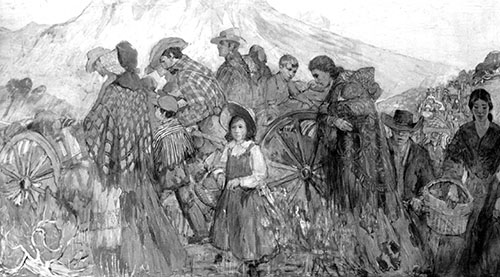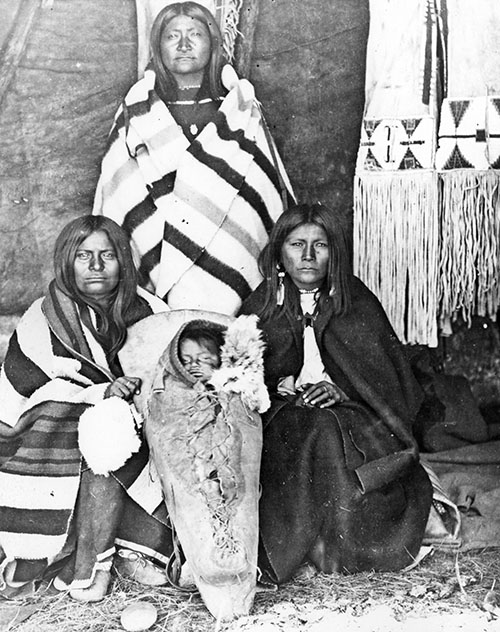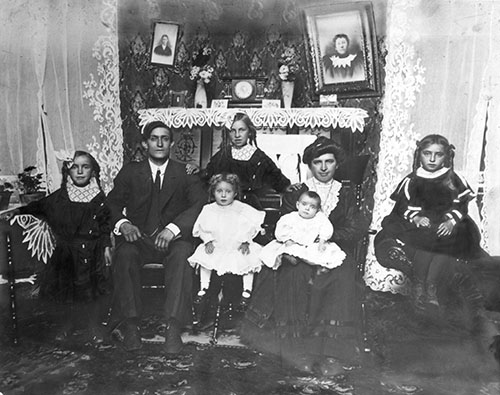Until the mid-1800s, the region that is now Utah was part of Spanish and Mexican territory. Native Americans lived in the Great Basin long before Spanish and the Americans chose to colonize the area.
In Short

After 1803, the United States government began to gain more and more land in the West. Americans hoped to expand their empire across the continent from the Mississippi River all the way to the Pacific Ocean. Utah was part of this huge territory. American desires to push west grew stronger after Mexico won its independence from Spain in 1821. During the 1820s and 1830s, British and American fur traders and explorers moved into Utah. They transformed ecosystems and Native American life through the fur trade and sent reports back to the Americans about the land and people here.
During the 1830s and 1840s, hundreds of American migrants began moving west to reach the fertile lands of Oregon and California. One large group was made up of migrants from the Church of Jesus Christ of Latter-day Saints (LDS), who came west planning to stay in Utah. Shortly after this, Utah became a US territory, and thousands of settlers poured into the region from all over the world.
More of the Story
The land that is now Utah changed hands between European empires three times over almost 400 years. This region was part of the Spanish Empire for 300 years (from the 1500s to 1821). In 1821 Mexico gained its independence from Spain, and for the next 30 years Utah was part of northern Mexico. Then in 1848, this region became part of the United States.
During all of this time, most of the people living in Utah were Native American peoples from the Goshute, Navajo, Paiute, Shoshone, and Ute cultures. Each of the European empires interacted with Native American peoples in different ways. Each of the empires spurred massive changes to ecosystems, economies, and tribal relations for Native peoples.

The Spanish Empire began a trading system that connected southern Utah’s Navajo, Ute, and Paiute peoples with New Mexico. After Mexico gained its independence, people from the British and American empires came into northern Utah to trap, trade, explore, and map. This fur trade involved Ute and Shoshone peoples who lived in northern Utah. The government of Mexico was located far away in Mexico City, and did not have the means to stop these traders. American trappers and explorers sent reports back to the United States about the peoples, trails, lands, and resources of the region. These reports paved the way for mass migration and settlement.
Large numbers of people from the United States began migrating into the northern territories of Mexico in the 1840s. This included members of the LDS church, who began arriving in 1847. In 1848, at the end of the Mexican-American War, the United States took over all of Mexico’s northern territory, including Colorado, Utah, Nevada, and California. Utah had become part of America.
Native Americans and Newcomers
During this time, the US Army established several forts in Utah. In response to ongoing conflict, an army unit attacked a winter village of Shoshone people on the banks of the Bear River. The soldiers killed more than 400 Shoshones, including women, children, and the elderly. This horrific event is known as the Bear River Massacre today. It was the largest massacre of Native people west of the Mississippi River.

This show of power forced Native people in the region to sign treaties promising peaceful relations in return for food, essential goods, and in some cases reservation lands. But in many cases, these treaty agreements were forgotten or ignored by the settlers.
Within a few short decades, American settlers pushed Native peoples off of the best lands to make way for their towns and farms. A good example of this is Provo. This fertile area next to the Provo River and Utah Lake had plentiful fishing, water, and food sources, and was home to a large community of Timpanogos Utes. The LDS settlers forced the Utes to leave their fertile homes in Utah’s valleys and move to a reservation where the land was poor.
In contrast, sometimes Paiutes moved near the new settlements and worked for LDS farmers, ranchers, and housewives. Shoshone and Goshute bands continued to live in small communities outside settled areas. Navajos were forced to walk 400 miles to a prison camp in New Mexico before they received a reservation.
All of these Native peoples found new ways to provide for their communities in a changed world.
Global Migrations
In 1869, the first transcontinental railroad was finished, connecting Utah with markets in California and the East. The railroad made it much cheaper and easier to migrate. It also made it possible to begin mining and other industries in the region. The combination of railroads and new industries drew thousands more immigrants to Utah from all over the world.

Religion attracted thousands of people from Scandinavia and Great Britain. Others came from Hawai’i and the Pacific Islands to join the LDS community in Utah. Job opportunities attracted thousands more from all over the world. Some came from China and Japan to work for the railroad and mining companies. Others came from Greece, Italy, and other countries in southern and eastern Europe.
These new Utahns spoke more than 30 different languages, practiced different religions, and ate different foods. All of them helped to build new communities, farms, and industries. In the process, they changed Utah’s lands and ecosystems through irrigation, grazing, logging, mining, and other activities. After settlement began, Utah’s lands and peoples changed dramatically.
Keep Exploring!